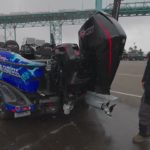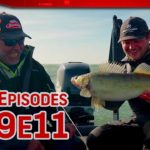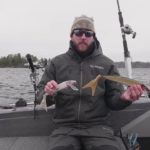Conventional “Wisdom” “¦ the Good, the Bad, and the Debatable
 There’s a couple feet of snow on the ground right now, so I guess you could say winter has arrived. Yet the arguments and debates drone on. Truth be told, they never do actually let up between muskie fishing seasons. Someone innocently asks a simple question about muskie behavior or fishing tactics – on a web site message board, or in a pub – and the nearest "expert" will quickly weigh in. Question answered? Not hardly. In a blink, another nearby expert – or the next fastest typist – will counter with a diametrically opposed opinion. Soon, sides are chosen and the hog-piling begins. Yesterday’s guru is today’s chump. What happened?
There’s a couple feet of snow on the ground right now, so I guess you could say winter has arrived. Yet the arguments and debates drone on. Truth be told, they never do actually let up between muskie fishing seasons. Someone innocently asks a simple question about muskie behavior or fishing tactics – on a web site message board, or in a pub – and the nearest "expert" will quickly weigh in. Question answered? Not hardly. In a blink, another nearby expert – or the next fastest typist – will counter with a diametrically opposed opinion. Soon, sides are chosen and the hog-piling begins. Yesterday’s guru is today’s chump. What happened?
What happened – what happens – is that whichever opinion falls under the umbrella of conventional wisdom (CW) soon dominates the conversation and pummels the opinions that deviate. Don’t get me wrong. I’m not complaining. Despite taking their lumps in the various debates, most folks who fish in frequent defiance of CW are doing just fine.
Let’s look at a few examples of CW. Let’s consider some situations when it’s a good idea to conform, and some others when it’s a good idea to defy CW. You see, I’m not advocating a thoughtless, universal rejection of muskie-fishing CW. I’m just suggesting that you should critically evaluate assumptions and tactics that everyone else is buying into – before you jump on the bandwagon.
Let’s look at opening day muskie fishing.
Early Season CW Rule 1
Fish shallow… fish in the spawning bays … find the warmest bays (often south-facing) and pound the shallows. There is some logic to this. Most of the fish may well be in or near these bays. You’ll see a lot of fish. Problem is – if the fish are there to spawn, they will not be in a mood for much else. Your lures will finish a very distant second in the competition for a muskie’s attention. Sure, if we’ve had an early spring, and the muskies have had plenty of time to recover from the spawn, they may be interested in your lures. But if the shallow bay muskies appear disinterested, you may find less-distracted muskies out on the edges, or even suspended in open water. Suspended, open-water muskies have saved many opening days for me – in Wisconsin, Ontario, and Minnesota. Paul Klien, muskie guide, Esox Angler contributor, and noted rejecter of CW has raised early season suspended muskie fishing to an art form.
 Early Season CW Rule 2
Early Season CW Rule 2
Fish small lures. Some say this is to match the hatch of the small-sized prey selection early spring offers. Do you believe that? Don’t you think a 50-inch muskie would eagerly jump on a nice juicy 4-pound cisco if it had a shot at one – even though the cisco didn’t "match" the trillions of 2-inch young-of-the-year baitfish swimming around?
But not so fast. There is some logic here. If you are casting into clear shallow water, well inside the newly emerging weedbed, then small does have an obvious advantage. Let’s say you’re casting into 2 feet of very clear water, with absolutely no cover. Let’s say you drop a six-ounce Reef Hawg three feet from a spooky muskie in two feet of water. From the muskie’s perspective that lure is going to hit the water like a cinder block. The muskie will scoot to the nearest breakline – and may not slow down until it’s across the lake. In this example, going with CW – going small with 3/8-ounce jig and lizard may have been a better choice. But if you’re looking for muskies buried in a lush, 8-foot deep weedbed, then throw your 2-ounce spinnerbait. If you’re trolling for suspended opening day muskies, then troll your full-sized Believers, Depth Raiders, and Jakes.
There is one piece of fishing CW where I stand in a very small minority. It comes up whenever the issue of triggering a muskie strike is discussed. Legitimate debate, calling on each "expert’s" tiny arsenal of anecdotal evidence, centers around the relative importance of color, action, speed, size, depth, angle of retrieve, putting fancy moves on the bait, etc. etc. … But it all comes down to the question: What is it, exactly, that makes the muskie EAT?
This is where I question the question. I think we anthropomorphize the muskie when we assume the act of eating every time a muskie attacks an object with the only weapon it has. I think that when a muskie follows a lure that has invaded its territory, often baring its teeth, it is simply to chase the nuisance away. I don’t think the muskie is pondering whether or not it’s hungry. And when a muskie strikes on a figure-8, I don’t think it is to eat – so much as to destroy the stupid thing. The intruder the muskie has been chasing away from it’s turf, suddenly turns back, and refuses to flee? Chomp. To paraphrase Tina Turner: "What’s ‘food’ got to do with it?"
Catch a nice one and let it go. Let them ALL go.





